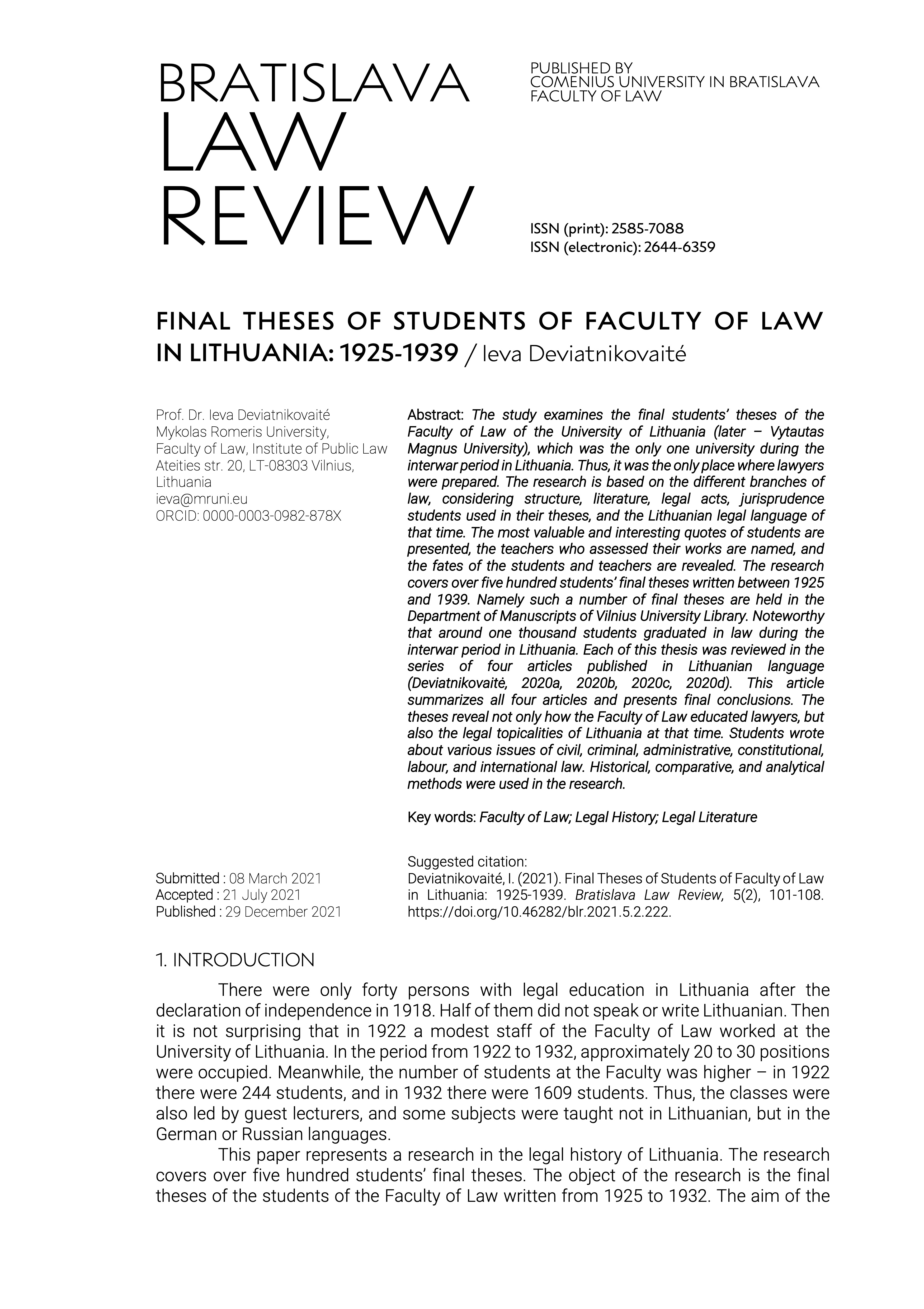Final Theses of Students of Faculty of Law in Lithuania: 1925-1939
DOI:
https://doi.org/10.46282/blr.2021.5.2.222Keywords:
Faculty of Law, Legal History, Legal LiteratureAbstract
The study examines the final students’ theses of the Faculty of Law of the University of Lithuania (later – Vytautas Magnus University), which was the only one university during the interwar period in Lithuania. Thus, it was the only place where lawyers were prepared. The research is based on the different branches of law, considering structure, literature, legal acts, jurisprudence students used in their theses, and the Lithuanian legal language of that time. The most valuable and interesting quotes of students are presented, the teachers who assessed their works are named, and the fates of the students and teachers are revealed. The research covers over five hundred students’ final theses written between 1925 and 1939. Namely, such a number of final theses are held in the Department of Manuscripts of Vilnius University Library. Noteworthy that around one thousand students graduated in law during the interwar period in Lithuania. Each of this thesis was reviewed in the series of four articles published in the Lithuanian language (Deviatnikovaitė, 2020a, 2020b, 2020c, 2020d). This article summarizes all four articles and presents final conclusions. The theses reveal not only how the Faculty of Law educated lawyers, but also the legal topicalities of Lithuania at that time. Students wrote about various issues of civil, criminal, administrative, constitutional, labour, and international law. Historical, comparative, and analytical methods were used in the research.
References
Baudžiamasis kodeksas (1919). Lithuania: Laikinosios vyriausybės žinios.
Deviatnikovaitė, I. (2020a). Teisių fakulteto studentų darbai 1925–1939. I dalis (1925–1932). Law Review, 21(1), pp. 21–60. DOI: https://doi.org/10.7220/2029-4239.21.2 DOI: https://doi.org/10.7220/2029-4239.21.2
Deviatnikovaitė, I. (2020b). Teisių fakulteto studentų darbai 1925–1939. II dalis (1933–1934). Law Review, 21(1), pp. 61–105. DOI: https://doi.org/10.7220/2029-4239.21.3 DOI: https://doi.org/10.7220/2029-4239.21.3
Deviatnikovaitė, I. (2020c). Teisių fakulteto studentų darbai 1925–1939. III dalis (1935–1937). Law Review, 21(1), pp. 106–153. DOI: https://doi.org/10.7220/2029-4239.21.4 DOI: https://doi.org/10.7220/2029-4239.21.4
Deviatnikovaitė, I. (2020d). Teisių fakulteto studentų darbai 1925–1939. IV dalis (1937–1939). Law Review, 21(1), pp. 154–195. DOI: https://doi.org/10.7220/2029-4239.21.5 DOI: https://doi.org/10.7220/2029-4239.21.5
Jaugelis, J. (1939). Normatyvinė valdymo organų galia Lietuvos konstitucinėje teisėje. Vytauto Didžiojo Universitetas.
Krasauskas, L. (1932). Atstovavimas įgaliojimui. Vytauto Didžiojo Universitetas.
Lietuvos universiteto Teisių fakulteto regulaminas ir mokslo planas. (1923). Teisių fakulteto leidinys.
Lietuvos valstybės laikinosios Konstitucijos pamatiniai dėsniai (1918). Lithuania: Laikinosios vyriausybės žinių papildymas.
Maksimaitis, M. (2002). Teisių mokslai. In: E. Aleksandravičius (Ed.), Mokslas ir visuomené 1922-2002 (pp. 325–344). Kaunas: Vytauto Didžiojo universitetas.
Meškauskas, J. (1932). Teisinė reikšmė Tautų Sąjungos Lietuvai. Vytauto Didžiojo Universitetas.
Šalkauskis, S. (1926). Bendrosios mokslinio darbo metodikos pradai. Kaunas.
Šalkauskis, S. (1933). Bendrosios mokslinio darbo metodikos pradai. Sakalo b-vė.
Volfas, J. (1939). Tiesioginis ir reprezentacinis valdymas. Vytauto Didžiojo Universitetas.
Zaleskis, L. (1937). Spaudos cenzūra nepriklausomoje Lietuvoje. Vytauto Didžiojo Universitetas.

Downloads
Published
Issue
Section
Categories
License
Copyright (c) 2021 Bratislava Law Review

This work is licensed under a Creative Commons Attribution-NonCommercial-NoDerivatives 4.0 International License.
The Author(s) transfers copyright to the Article to the Publisher of the Journal by the Licence Agreement.
The Author(s) retains rights specified in the Licence Agreement.
The readers may read, download, copy, distribute, print, search, or link to the full texts of all of the Article of the Journal and use them for any other lawful purpose under specified Creative Commons Licence (CC BY-NC-ND 4.0).











